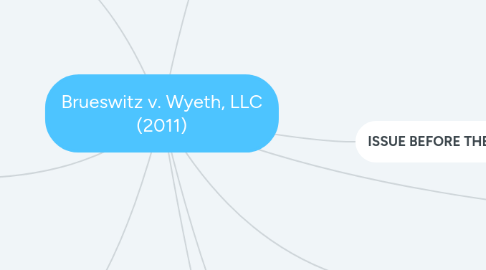
1. IMPACT
1.1. Milik v. Secretary of Health and Human Services
1.1.1. Parents petitioned for compensation, under National Childhood Vaccine Injury Act (Vaccine Act), for their disabled son whose severe neurological condition involving developmental delay, spastic diplegia, and motor difficulties was allegedly caused by measles, mumps, and rubella (MMR) vaccine
1.1.1.1. Because the Miliks failed to show that the MMR vaccination caused A.M.'s injury, they did not meet their burden under the second Althen prong, and the special master correctly denied the petition for compensation
1.2. Holmes v. Merck
1.2.1. Parents of deceased child filed action in state court against vaccine manufacturer alleging negligence, strict product liability, negligent design, failure to warn, misrepresentation, express warranty, implied warranty of merchantability, implied warranty of fitness for a particular purpose, and punitive damages.
2. IMPORTANCE
2.1. A business professional would care about this for many reasons including...
2.1.1. If they are in the pharmaceutical industry because it could shield them from lawsuits when they are developing new vaccines
2.1.2. It shows the strength and protection an Act passed by congress can give you
3. INFLUENCE
3.1. Workers Compensation
3.1.1. Gallup Med Flight v. Builders Trust of New Mexico (2017)
3.1.1.1. The medical necessity of the flight at transportation preempted any processes or procedures previous agreed to
3.2. Taxation
3.2.1. US v. Woods
3.2.1.1. A general partnership that allowed Woods to reduce their taxable income does not deserve a fine because the legislation was passed before the Blue Book so it did not inform the new law and is not a legitimate tool to interpret statutes
4. The court affirmed the 3rd Circuit, holding that the NCVIA preempts all design-defect claims against vaccine manufacturers brought by plaintiffs seeking compensation for injury or death caused by a vaccine's side effects
5. FACTS
5.1. Parties
5.1.1. Russell and Robalee Brueswitz
5.1.2. Wyeth, LLC
5.2. What Happened
5.2.1. In 1992, Hannah Bruesewitz, the three year olf daughter of the plaintiffs/petitioners received Wyeth's Tri-Immunol DTP vaccine as part of childhood immunizations
5.2.1.1. Due to defects in the vaccines, Hannah (the daughter) developed chronic seizures and was hospitalized for weeks
5.2.1.1.1. Plaintiff filed suit in federal claims court in 1995. Following the suit in 1998 Wyeth removed the vaccine from circulation
5.2.1.2. Brueswitz filed suit in Pennsylvania state court.
5.2.1.2.1. In Pennsylvania state court they allgeged that the defective design of Lederle's (purchased by Wyeth) DTP vaccine caused Hannah's disabilities, and that Lederle(Wyeth) was subject to strict liability and liability for negligent design under Pennsylvania common law
5.3. Procedural History
5.3.1. The Bruesewitzes claimed that Hannah's seizures and later developmental problems came from the vaccine
5.3.1.1. Initially, they filed suit in the "Vaccine Court", a special court within the United States Court of Federal Claims.
5.3.2. The Brueswitzs appealed to the Supreme Court
6. ISSUE BEFORE THE COURT
6.1. Whether the National Childhood Vaccine Injury Act of 1986 preempts design-defect claims against vaccine manufacturers
7. RULE OF LAW
7.1. The NCVIA preempts all design-defect claims against vaccine manufacturers brought by plaintiffs seeking compensation for injury or death caused by a vaccine's side effects.
8. APPLICATION
8.1. Wyeth argues that the National Childhood Vaccine Injury Act of 1986 protects them and preempts relevant tort law
8.1.1. And they are completely protected by the NCVIA which states that no vaccine manufacturer shall be liable in a civil action for damages arising from a vaccine-related injury or death associated with the administration of a vaccine after October 1, 1988, if the injury or death resulted from side-effects that were unavoidable even though the vaccine was properly prepared and was accompanied by proper directions and warnings.
8.1.1.1. Congress implemented the NCVIA so that vaccine manufacturers would continue to innovate because vaccines are important to society. Side effects affecting people from taking vaccines is unavoidable, but this gives them the right to file a suite in Federal Claims Court (vaccine court) which allows the average person to get financial restitution. Furthermore, then they could try in district court. In return for this protection the vaccine manufacturers pay a tax on the vaccines which pays the plaintiffs.
8.1.1.1.1. The court broadened its interpretation of the law
8.2. Plaintiff has the burden of proving...
8.2.1. The Vaccine caused their daugher's disability
8.2.1.1. And the disability was avoidable which means the company is open to question in a tort action
8.2.2. That the defective design makes the company subject to strict liability and liability for negligent design under Pennsylvania common law
8.2.3. That the Act does not preempt their products liability claim
